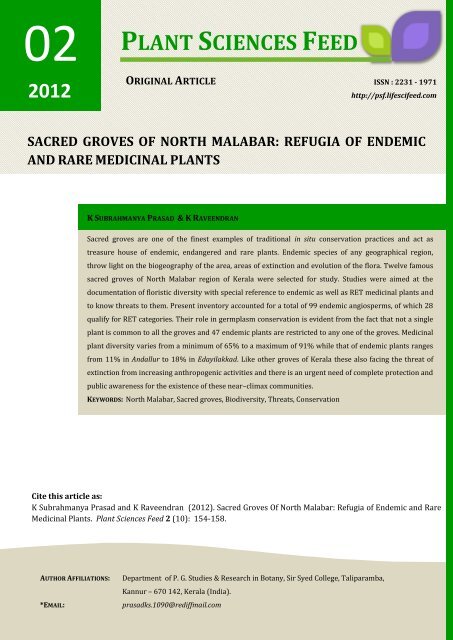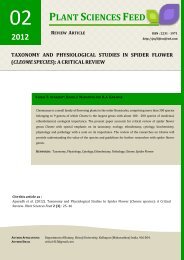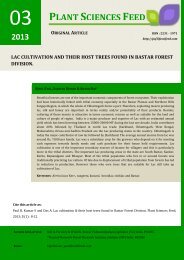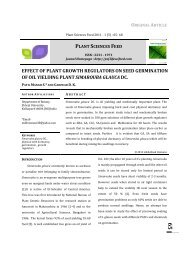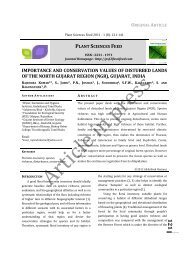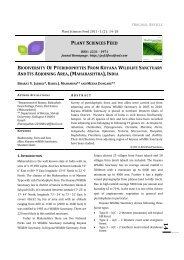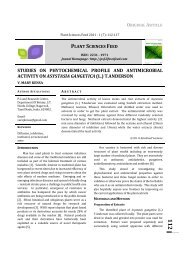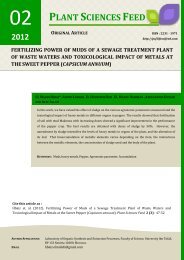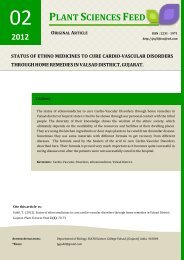Sacred Groves Of North Malabar - Plant Sciences Feed - LifeSciFeed
Sacred Groves Of North Malabar - Plant Sciences Feed - LifeSciFeed
Sacred Groves Of North Malabar - Plant Sciences Feed - LifeSciFeed
You also want an ePaper? Increase the reach of your titles
YUMPU automatically turns print PDFs into web optimized ePapers that Google loves.
02<br />
2012<br />
PLANT SCIENCES FEED<br />
ORIGINAL ARTICLE<br />
ISSN : 2231 - 1971<br />
http://psf.lifescifeed.com<br />
SACRED GROVES OF NORTH MALABAR: REFUGIA OF ENDEMIC<br />
AND RARE MEDICINAL PLANTS<br />
K SUBRAHMANYA PRASAD & K RAVEENDRAN<br />
<strong>Sacred</strong> groves are one of the finest examples of traditional in situ conservation practices and act as<br />
treasure house of endemic, endangered and rare plants. Endemic species of any geographical region,<br />
throw light on the biogeography of the area, areas of extinction and evolution of the flora. Twelve famous<br />
sacred groves of <strong>North</strong> <strong>Malabar</strong> region of Kerala were selected for study. Studies were aimed at the<br />
documentation of floristic diversity with special reference to endemic as well as RET medicinal plants and<br />
to know threats to them. Present inventory accounted for a total of 99 endemic angiosperms, of which 28<br />
qualify for RET categories. Their role in germplasm conservation is evident from the fact that not a single<br />
plant is common to all the groves and 47 endemic plants are restricted to any one of the groves. Medicinal<br />
plant diversity varies from a minimum of 65% to a maximum of 91% while that of endemic plants ranges<br />
from 11% in Andallur to 18% in Edayilakkad. Like other groves of Kerala these also facing the threat of<br />
extinction from increasing anthropogenic activities and there is an urgent need of complete protection and<br />
public awareness for the existence of these near–climax communities.<br />
KEYWORDS: <strong>North</strong> <strong>Malabar</strong>, <strong>Sacred</strong> groves, Biodiversity, Threats, Conservation<br />
Cite this article as:<br />
K Subrahmanya Prasad and K Raveendran (2012). <strong>Sacred</strong> <strong>Groves</strong> <strong>Of</strong> <strong>North</strong> <strong>Malabar</strong>: Refugia of Endemic and Rare<br />
Medicinal <strong>Plant</strong>s. <strong>Plant</strong> <strong>Sciences</strong> <strong>Feed</strong> 2 (10): 154-158.<br />
AUTHOR AFFILIATIONS: Department of P. G. Studies & Research in Botany, Sir Syed College, Taliparamba,<br />
Kannur – 670 142, Kerala (India).<br />
*EMAIL: prasadks.1090@rediffmail.com
1. INTRODUCTION<br />
<strong>Sacred</strong> groves are one of the finest examples of<br />
traditional in situ conservation practices, which dates<br />
much prior to the modern concept of wildlife reserves.<br />
These are patches of natural near-climax pristine<br />
vegetation of trees and associate groups of organisms,<br />
managed as a part of local cultural tradition. <strong>Sacred</strong><br />
groves are found in a wide range of ecological situations,<br />
from coast to the Ghats [1]. The area of a sacred grove<br />
varies from a few trees to about 20 hectares of multitier<br />
primary forest. Each grove has a patron deity and folklore<br />
associated with it [2]. Extensive studies conducted on the<br />
biodiversity and from biological conservation point of<br />
view indicated that they are the treasure house of<br />
medicinal, rare, endemic and endangered plants [3 – 7].<br />
<strong>Groves</strong> are repositories of biological wealth of the nation<br />
[8]. These act as last shelters of natural forests and are the<br />
indicators of the rich vegetation that had existed in the<br />
past. These are the store houses of germplasm of wild<br />
yams, pepper, mango and a variety of Ayurvedic as well as<br />
folk medicinal plants [9]. <strong>Sacred</strong> groves are important<br />
because about 60 % of the regenerating species in them<br />
are medicinally important and nearly 40% medicinal<br />
plants are unique to them [10]. In Kerala sacred groves<br />
are mainly distributed in plains, numbering about 2000<br />
[8] of which 578 are in <strong>North</strong> <strong>Malabar</strong> [11]. At present<br />
most of the sacred groves are on a path of gradual decline<br />
owing to various socio-economic factors [9]. Like other<br />
groves of Kerala sacred groves of <strong>North</strong> <strong>Malabar</strong> also<br />
facing the threat of extinction from increasing<br />
anthropogenic activities.<br />
Endemic plants are the population with narrow<br />
ecological restrictions. Endemic species of any<br />
geographical region, throw light on the biogeography of<br />
the area, areas of extinction and evolution of the flora [12].<br />
Identification and documentation of RET species is<br />
important in the conservation of biodiversity as these<br />
have specific ecological niches [13]. The threatened<br />
species categories used in red list are critically<br />
endangered, endangered and vulnerable [14]. Rare<br />
species is the one which occurs in widely separated small<br />
sub population, where inter breeding is restricted to a<br />
single population. Present studies were mainly aimed at<br />
the exploration of medicinal plant diversity with special<br />
reference to RET plants and the threats to them.<br />
2. MATERIALS AND METHODOLOGY<br />
Area selected for study is <strong>North</strong> <strong>Malabar</strong> region of<br />
Kerala, located to the <strong>North</strong> east of Kerala within the<br />
geographical limit 11° 18' to 12° 48' N latitude and 74° 52'<br />
to 76° 07' E longitude, comprising Kasaragod and Kannur<br />
districts. Topographically the area consists of a narrow<br />
coastal belt, undulating midland and mountainous high<br />
range. The climate is typical warm-humid tropical type<br />
with mean temperature range of 22 – 37 o C and relative<br />
humidity between 70% and 90%. Studies were conducted<br />
from January 2007 to December 2009 throughout the<br />
twelve famous sacred groves, six each in both districts<br />
with an extent of over two acres. The groves selected for<br />
study were Andallur, Edayilakkad, Kalarivadukkal,<br />
Kunninmadilagam, Madai, Niliarkottam, (Kannur district)<br />
Kammadam, Karakka, Kayyur, Mapittacchery, Paliyeri and<br />
Paramel Kavu of Kasaragod district. Extensive field visits<br />
were carried out to document the floristic diversity. The<br />
plants were collected and identified with the aid of<br />
regional floras, checklists [15 – 23] and herbaria. The<br />
voucher specimens were deposited at the SSC herbaria.<br />
Personal cross-interview with the local people and<br />
authentic literature reference [24 – 31] were performed<br />
to ascertain the economic importance of the plants.<br />
3. RESULTS<br />
The vegetation of these groves is of secondary semievergreen<br />
type. The Pteridophytes are represented by<br />
Selaginella delicatula (Desv. ex Poir.) Alston., Lygodium<br />
flexuosum (L.) Sw., Pteris pellucida Presl., Adiantum<br />
lunulatum Burm. f., Vittaria elongata Sw., Ophioglossum<br />
reticulatum L., Chielanthes sp., Bolbites subcrenata (Hook.<br />
& Grev.) Ching., Lindsaea ensifolia Sw., Drynaria quercifolia<br />
(L.) J. Sm., Stenochlaena palustris (Burm.) Bedd.,<br />
Angiopteris evecta (G. Forst.) Hoffm., Christella dentata<br />
(Forssk.) Holttum., Trichomanes christi Copel., Hemionitis<br />
arifolia (Burm. f.) T. Moore., Alsophila gigantea Wall. ex<br />
Hook. while Gymnosperms by Gnetum ula Brongn. alone.<br />
Endemic plants, their distribution and status are<br />
shown in Table No. 1. Critical observation of endemic<br />
plant diversity in these groves revealed the presence of 99<br />
endemic angiosperms. Most astonishing fact is that not a<br />
single plant is common to the twelve groves studied.<br />
Dalbergia horrida (Dennst.) Mabb., Holigarna arnottiana<br />
Hook. f. and Mussaenda belilla Buch.-Ham. show their<br />
presence in all the groves except Kalarivadukkal.<br />
Restriction of 47 endemic plants to any one of the sacred<br />
grove makes them important gene pool. <strong>Of</strong> the 99<br />
endemic plants 28 fall under RET categories as there are<br />
13 vulnerable, 10 rare, 2 endangered, 2 critically<br />
endangered plants and Tabernaemontana heyneana Wall.,<br />
a nearly threatened one. Review of authentic literature<br />
and consultation with local people made it clear that out<br />
of these 59 were well known for their medicinal<br />
properties. Another striking feature is that 18 of these<br />
medicinal plants are included under RET categories. <strong>Plant</strong><br />
composition in each grove and their importance is given<br />
in Table No. 2.<br />
Page155<br />
<strong>Plant</strong> <strong>Sciences</strong> <strong>Feed</strong> Vol. 2 Issue 10
<strong>Plant</strong> <strong>Sciences</strong> <strong>Feed</strong> Vol. 2 Issue 10<br />
Table 1. Distribution of endemic plants.<br />
Sl No Botanical name Status A E K<br />
K<br />
M<br />
K<br />
R<br />
K<br />
V<br />
K<br />
Y<br />
M M<br />
P<br />
N P<br />
1 Actinodaphne bourdillonii Gamble LC X<br />
2 Aglaia barberi Gamble R X X<br />
3 *Aglaia elaeagnoidea (A. Juss.) Benth. LC X X X X X X<br />
4 *Amorphophallus commutatus (Schott) Engl. LC X X X X X<br />
5 *Ampelocissus indica (L.) Planch R X X<br />
6 Ancistrocladus heyneanus Wall ex Graham LC X X<br />
7 Aneilema ovalifolium (Wight) Hook. f. R X<br />
8 Arisaema leschenaultii Blume LC X X<br />
9 *Artocarpus hirsutus Lam. V X X X<br />
10 Aspidopterys canarensis Dalz. V X X<br />
11 *Begonia canarana Miq. R, E X<br />
12 *Briedelia scandens (Roxb.) Willd. LC X X X X X X X<br />
13 *Bulbophyllum sterile (Lam.) Suresh LC X X X X X X X<br />
14 *Calamus thwaitesii Bec. & Hook. f. LC X X<br />
15 *Calophyllum calaba L. R X<br />
16 *Canthium rheedei DC. LC X<br />
17 Capparis floribunda Wight. LC X<br />
18 *Capparis grandiflora Wall ex Hook. f. LC X X X<br />
19 Chionanthus mala-elengi (Dennst) P. S. Green LC X<br />
20 *Cinnamomum malabatrum (Burm. f.) Blume LC X<br />
21 *Curcuma oligantha Trimen LC X X X X X X X X<br />
22 Cyanotis papilionacea (L.) Schult. f. LC X<br />
23 *Dalbergia horrida (Dennst.) Mabb. LC X X X X X X X X X X X<br />
24 *Dendrobium ovatum (L.) Kranz. LC X<br />
25 Derris brevipes (Benth) Baker LC X X<br />
26 *Diospyros candolleana Wight LC X<br />
27 *Ensete superbum (Roxb.) Cheesman V X<br />
28 Eranthemum capense L. LC X X X<br />
29 Euonymus indicus Heyne ex Roxb. LC X X<br />
30 Euphorbia katrajensis Gaje. LC X X<br />
31 Ficus beddomei King LC X<br />
32 *Flacourtia montana Graham LC X X<br />
33 Flagellaria indica L. R X<br />
34 Genianthus laurifolius (Roxb.) Hook. f. R X X X<br />
35 Globba ophioglossa Wight LC X<br />
36 Glochidion johnstonei Hook. f. LC X<br />
37 *Gloriosa superba L. V X X X X<br />
38 *Glycosmis macrocarpa Wight R X<br />
39 *Grewia umbellata Mast. LC X<br />
40 Gymnema hirsutum Wight & Arn. LC X<br />
41 *Gymnostachyum febrifugum Benth. LC X<br />
42 Helicanthes elastica (Dest.) Danser LC X X<br />
43 *Holigarna arnottiana Hook. f. LC X X X X X X X X X X X<br />
44 *Holigarna ferruginea Marchand LC X<br />
45 *Hopea parviflora Bedd. LC X X<br />
46 *Hopea ponga (Dennst.) Mabb. V X X X X X<br />
47 *Hydnocarpus macrocarpa (Bedd.) Warb. E X<br />
48 *Hydnocarpus pentandra (Buch.-Ham.) Oken. V X X X X X X<br />
49 *Impatiens minor (DC) Bennet LC X X X X X X X<br />
50 *Ixora brachiata Roxb. ex DC. LC X X X X X X X X<br />
51 Ixora leucantha Heyne ex G. Don LC X X X X X<br />
52 Ixora polyantha Wight LC X X X<br />
53 *Jasminum malabaricum Wight LC X X X X X X X<br />
54 *Justicia betonica L. LC X<br />
55 Justicia trinervia Vahl. LC X<br />
56 *Knema attenuata Hook. f. & Thoms. LC X X<br />
57 *Lagerstroemia microcarpa Wight LC X X<br />
58 *Lepidagathis keralensis Madhu. & Singh LC X X<br />
59 *Leucas biflora (Vahl.) R. Br. LC X<br />
60 *Litsea coriacea (Heyne ex Meisner) Hook. f. LC X<br />
P<br />
A<br />
Page156
61 Litsea ghatica Sald. LC X X<br />
62 Litsea laevigata (Nees) Gamble LC X<br />
63 *Loeseneriella arnottiana (Wight) A. C. Smith LC X X X X X X X<br />
64 Loeseneriella bourdillonii (Gamble) Ramam LC X X<br />
65 *Memecylon randerianum S M & M R Almeida LC X X X X X X X<br />
66 Memecylon talbotianum Brandis LC X<br />
67 Miquelia dentata Bedd. R X<br />
68 Morinda reticulata Gamble R X<br />
69 *Moullava spicata (Dalz.) Nicols LC X X<br />
70 Murdannia semiteres (Dalz.) Sant. LC X X X<br />
71 *Mussaenda belilla Buch.-Ham. LC X X X X X X X X X X X<br />
72 Myristica fatua Houtt. E X<br />
73 *Myristica malabarica Lam. V X X<br />
74 *Naregamia alata Wight & Arn. LC X X X X X X<br />
75 Neuropeltis malabarica Ooster C E X<br />
76 Oberonia brunoniana Wight LC X<br />
77 *Ochlandra travancorica (Bedd.) Benth. ex. Gamble LC X<br />
78 *Ochreinauclea missionis (Wall. ex G. Don.) Ridsd. V X<br />
79 Phoebe lanceolata Nees. LC X<br />
80 *Psychotria dalzellii Hook. f. LC X<br />
81 Psychotria flavida Talbot. LC X<br />
82 *Quisqualis malabarica Bedd. LC X<br />
83 Reissantia indica (Willd.) Halle LC X<br />
84 Rotala macrandra Koehne LC X<br />
85 *Salacia fruticosa Heyne ex Lawson LC X X<br />
86 *Santalum album L. V X X X X<br />
87 *Saraca asoca ( Roxb.) de wilde V X<br />
88 Smithia salsuginea Hance LC X<br />
89 *Stachyphrynium spicatum (Roxb.) Schum. LC X X<br />
90 *Strobilanthes ciliatus Nees V X<br />
91 Strobilanthes integrifolius (Dalz.) O. Ktze. LC X<br />
92 *Syzygium travancoricum Gamble C E X X<br />
93 *Tabernaemontana heyneana Wall. N T X X X X X X X X<br />
94 *Terminalia paniculata Roth. LC X X X<br />
95 *Tinospora sinensis (Lour.) Merr. V X X X X<br />
96 *Vateria indica L. V X X<br />
97 *Ventilago denticulata Willd. LC X<br />
98 Zingiber cernuum Dalz. LC X<br />
99 *Zingiber neesamum (Graham) Ramam LC X X<br />
where ‘*’ stands for medicinal, R – rare, E – endangered, V – vulnerable, CE – critically endangered, NT – near threatened, LC –<br />
least concerned, A – Andallur, E – Edayilakkad, K – Kammadam, KM – Kunninmadilagam, KR – Karakka, KV – Kalarivadukkal, KY<br />
– Kayyur, M – Madai, MP – Mapittacchery, N – Niliarkottam, P – Paliyeri and PA – Paramel Kavu.<br />
Table 2 - <strong>Plant</strong> composition and percentage of economically important plants.<br />
Category A E K KM KR KV K Y M MP N P PA<br />
Vascular <strong>Plant</strong>s 91 127 234 112 146 75 132 77 121 186 141 167<br />
Trees 35 23 75 25 31 23 30 17 28 53 32 38<br />
Shrubs 18 31 42 23 23 15 24 21 23 35 20 34<br />
Herbs 23 34 44 32 61 17 31 19 39 58 47 51<br />
Climbers 15 39 73 32 31 20 47 20 31 40 42 44<br />
Medicinal <strong>Plant</strong>s<br />
83<br />
(91%)<br />
107<br />
(84%)<br />
161<br />
(69%)<br />
95<br />
(85%)<br />
108<br />
(74%)<br />
68<br />
(91%)<br />
112<br />
(85%)<br />
68<br />
(88%)<br />
96<br />
(79%)<br />
148<br />
(80%)<br />
101<br />
(72%)<br />
109<br />
(65%)<br />
Edible <strong>Plant</strong>s<br />
27<br />
(30%)<br />
34<br />
(27%)<br />
48<br />
(21%)<br />
20<br />
(18%)<br />
32<br />
(22%)<br />
27<br />
(36%)<br />
41<br />
(31%)<br />
25<br />
(33%)<br />
37<br />
(31%)<br />
46<br />
(25%)<br />
31<br />
(22%)<br />
38<br />
(23%)<br />
Endemic plants<br />
10<br />
(11%)<br />
23<br />
(18%)<br />
39<br />
(17%)<br />
18<br />
(16%)<br />
17<br />
(12%)<br />
10<br />
(13%)<br />
16<br />
(12%)<br />
13<br />
(17%)<br />
15<br />
(12%)<br />
29<br />
(16%)<br />
19<br />
(13%)<br />
27<br />
(16%)<br />
where, A – Andallur, E – Edayilakkad, K – Kammadam, KM – Kunninmadilagam, KR – Karakka, KV – Kalarivadukkal, KY –<br />
Kayyur, M – Madai, MP – Mapittacchery, N – Niliarkottam, P – Paliyeri and PA – Paramel Kavu.<br />
Page157<br />
<strong>Plant</strong> <strong>Sciences</strong> <strong>Feed</strong> Vol. 2 Issue 10
4. CONCLUSION<br />
The percentage of medicinal plants in these groves<br />
varies from a minimum of 65 in Paramel Kavu to a<br />
maximum of 91 in Andallur and Kalarivadukkal. The<br />
maximum percentage of endemic plants is 18 in<br />
Edayilakkad while minimum 11 in Andallur. This much<br />
richness in species diversity makes these groves<br />
biological hotspots. Like other groves of Kerala<br />
anthropogenic activities like collection of firewood,<br />
dumping of waste and many antisocial elements are the<br />
major threats for the gene pool of these fragile<br />
ecosystems. Their presence in agriculture lands, grazing,<br />
fragmentation and erosion of religious beliefs are also<br />
the added influence of anthropogenic activities. Thus<br />
conservation of biodiversity of these sacred groves is an<br />
urgent need. For effective conservation fencing of the<br />
outer perimeter to prevent tress passing, total ban on<br />
the exploitation of natural resources from them, allowing<br />
entry to those who come for worship and posting<br />
security to guard the entry point are recommended.<br />
5. ACKNOWLEDGEMENTS<br />
The authors are thankful to the Principal and<br />
Management, Sir Syed College, Taliparamba for<br />
providing the facilities. One of the authors, SPK is<br />
grateful to Kerala State Council for Science Technology<br />
and Environment (KSCSTE) for providing financial<br />
assistance.<br />
6. REFERENCES<br />
[1] Gadgil M, Vartak VD. The sacred groves of Western<br />
Ghats in India. Economic Botany 1976; 30: 152 – 160.<br />
[2] Nair GH, Gopikumar K, Pramod G, Krishnan, Sunil<br />
Kumar KK. <strong>Sacred</strong> groves of India – Vanishing<br />
greenery. Current Science 1997; 72 (10): 697 – 698.<br />
[3] Chandran MDS, Gadgil M, Hughes JD. <strong>Sacred</strong> groves<br />
of the Western Ghats. In: Ramakrishnan PS, Saxena<br />
KG, Chandrashekara UM, Eds. Conserving the sacred<br />
for Biodiversity Management. Oxford and IBH<br />
Publishing Co., New Delhi 1998; 211 – 232.<br />
[4] Chandrashekara UM, Sankar S. Structure and<br />
Function of sacred groves: Case studies in Kerala, In:<br />
Ramakrishnan PS, Saxena KG, Chandrashekara UM,<br />
Eds. Conserving the sacred for Biodiversity<br />
Management. Oxford and IBH Publishing Co., New<br />
Delhi 1998; 323 – 336.<br />
[5] Deb D, Deuti K, Malhotra KC. <strong>Sacred</strong> grove relics as<br />
bird refugia. Current Science 1997; 73 (4): 815 – 817.<br />
[6] Pushpangadan P, Rajendraprasad M, Krishnan RN.<br />
<strong>Sacred</strong> groves of Kerala: A synthesis of art of<br />
knowledge, In: Ramakrishnan PS, Saxena KG,<br />
Chandrashekara UM, Eds. Conserving the sacred for<br />
Biodiversity Management. Oxford and IBH Publishing<br />
Co., New Delhi 1998; 193 – 210.<br />
[7] Gokhale Y, Velankar R, Chandran MDS, Gadgil M.<br />
<strong>Sacred</strong> woods, grasslands and water bodies as selforganized<br />
systems of conservation, In:<br />
Ramakrishnan PS, Saxena KG, Chandrashekara UM,<br />
Eds. Conserving the sacred for Biodiversity<br />
Management. Oxford and IBH Publishing Co., New<br />
Delhi 1998; 365 – 398.<br />
[8] Malhotra KC, Gokhale Y, Chatterjee S. Cultural and<br />
ecological dimensions of sacred groves in India,<br />
<strong>Plant</strong> <strong>Sciences</strong> <strong>Feed</strong> Vol. 2 Issue 10<br />
Indira Gandhi Rashtriya Manav Sangrahalaya,<br />
Bhopal, 2001.<br />
[9] Bhandari MJ, Chandrashekhar KR. <strong>Sacred</strong> groves of<br />
Dakshina Kannada and Udupi districts of Karnataka.<br />
Current Science 2003; 85 (12): 1655 – 1656.<br />
[10] Boraiah KT, Vasudeva R, Bhagwat SA, Kushalappa<br />
CG. Do informally managed sacred groves have<br />
higher richness and regeneration of medicinal plants<br />
than state-managed reserve forests?. Current Science<br />
2003; 84 (6): 804 – 808.<br />
[11] Jayarajan M. <strong>Sacred</strong> groves of <strong>North</strong> <strong>Malabar</strong>,<br />
Discussion paper No. 92, KRPLLD,<br />
Thiruvananthapuram, 2004.<br />
[12] Ramesh BR, Pascal JP. Symposium on rare endangered<br />
and endemic plants of the Western Ghats (India)<br />
Kerala. Proc. Distribution of endemic arborescent<br />
evergreen species in the Western Ghats, Forest<br />
Department, Thiruvananthapuram, 1991; 20 – 29.<br />
[13] Varghese AO, Menon ARR. Ecological niches and<br />
amplitudes of rare, threatened and endemic trees of<br />
Peppara Wildlife Sanctuary. Current Science 1999;<br />
76 (9): 1204 – 1208.<br />
[14] IUCN. IUCN Red List categories, IUCN Publications,<br />
Gland, Switzerland, 2010.<br />
[15] Hooker JD. Flora of British India, 7 Vols., Reeve and<br />
Co., London, 1897.<br />
[16] Gamble JS, Fischer CEC. Flora of Presidency of<br />
Madras, 3 Vols., Adlard & Son Ltd., London, 1936.<br />
[17] Manilal KS, Sivarajan VV. Flora of Calicut, Bishen<br />
Singh Mahendra Pal Singh, Dehra Dun, 1982.<br />
[18] Mathew KM. The Flora of Tamilnadu Carnatic, 3<br />
Vols., The Rapinat Herbarium, St Joseph’s College,<br />
Thiruchirapalli, 1984.<br />
[19] Ramachandran VS, Nair VJ. Flora of Cannanore. BSI,<br />
Calcutta, 1988.<br />
[20] Bhat KG. Flora of Udupi, Indian Naturalist (R), Udupi,<br />
2003.<br />
[21] Sasidharan N. Flowering plants, KFRI Handbook No.<br />
17, KFRI, Peechi, 2004.<br />
[22] Anil Kumar N, Sivadasan M, Ravi N. Flora of<br />
Pathanamthitta, Daya Publishing House, Delhi, 2005.<br />
[23] Nayar TS, Beegam AR, Mohanan N, Rajkumar G.<br />
Flowering plants of Kerala, TBGRI, Palode, 2006.<br />
[24] Kirtikar KR, Basu BD. Indian Medicinal <strong>Plant</strong>s, 4 Vols.,<br />
Lalit Mohan Basu, Allahabad, 1935.<br />
[25] Anonymous. Wealth of India – Raw materials, 12<br />
Vols., Publication & Information Directorate, CSIR,<br />
New Delhi, 1976.<br />
[26] Nadkarni KM. Indian Materia Medica, 2 Vols., Popular<br />
Prakashan Pvt. Ltd., Bombay, 1954.<br />
[27] Chopra RN, Nayar SL, Chopra IC. Glossary of<br />
Medicinal <strong>Plant</strong>s, Publication & Information<br />
Directorate, CSIR, New Delhi, 1956.<br />
[28] Ambasta SP. The Useful <strong>Plant</strong>s of India, Publication &<br />
Information Directorate, CSIR, New Delhi, 1986.<br />
[29] Jain SK. Dictionary of Indian Folk Medicine and<br />
Ethnobotany, Deep Publications, New Delhi, 1991.<br />
[30] Sivarajan VV, Balachandran I. Ayurvedic Drugs and<br />
their <strong>Plant</strong> source, Oxford & IBH Publishing Co. Pvt.<br />
Ltd., New Delhi, 1994.<br />
[31] Warrier PK, Nambiar VPK, Ramankutty. Indian<br />
Medicinal <strong>Plant</strong>s – A Compendium of 500 species, 5<br />
Vols., Orient Longman Ltd., Madras, 1994.<br />
Page158


